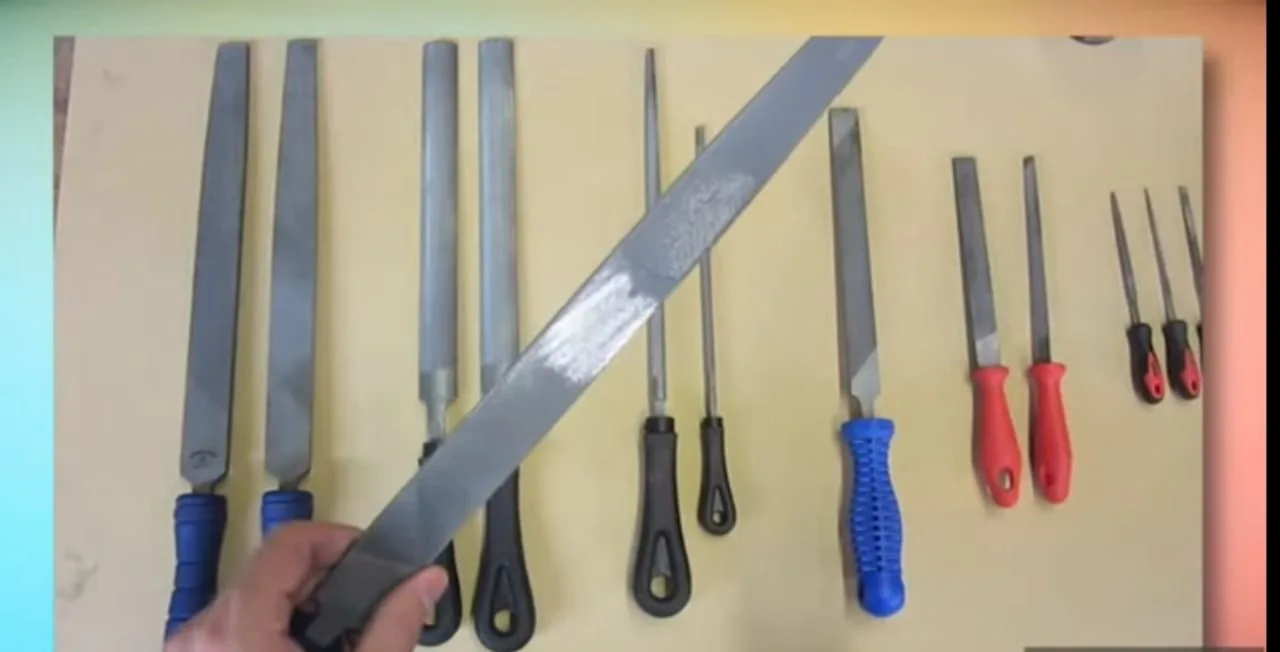Table of Contents
what is Files?
The process of removing unwanted material in the form of powder by rubbing a rough surfaced tool from the surface of a workpiece is called filing and the cutting tool used for this purpose is called file.
With the help of sandpaper, we can remove excess material in the form of fine particles from plane surfaces, curved surfaces, straight slots, circular or rectangular holes and almost every type of shape.
File and Rasp – What’s the Difference?
Let’s imagine you’re shaping a piece of wood or metal. You want it to be just right — smooth, neat, and the exact shape you need. That’s where files and rasps come in. They may look a little similar, but they work in different ways.
🌟 Files – Smooth and Sharp
A file is a tool with lots of tiny teeth lined up in straight rows. These teeth help you shape and smooth surfaces by rubbing the file against them.
- Single-cut file: This has one set of teeth. It gives a neat and smooth finish. It’s great for sharpening tools like knives or saws. Just use light pressure and go slow.
- Double-cut file: This one has two sets of teeth that cross each other. It removes material faster. You can use it to shape metal, remove rust, or smooth wood. Use firm pressure while working.
- Curved-cut file: The teeth are curved across the tool’s face. It’s often used in car work, like smoothing a car’s body. It also works well on plaster or fiberglass.
- Rasp-cut file: This one looks rough and has big, single teeth. It’s mainly used for working on wood.
Rasps – Rough and Quick
A rasp is a tool with big, rough teeth scattered all over. It doesn’t make things super smooth, but it removes material fast.
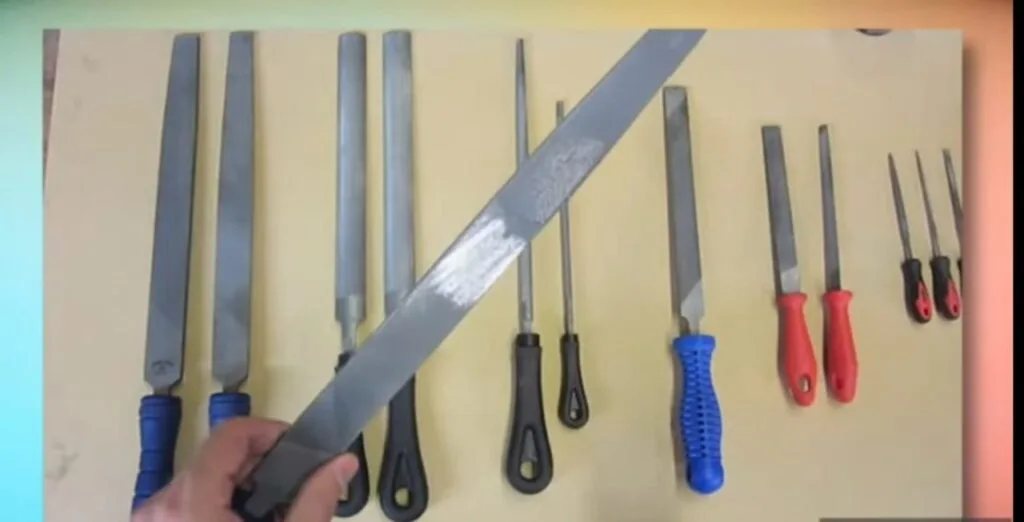
- Wood rasp: Very rough. Great for quickly shaping wood or removing large pieces.
- Cabinet rasp: A little finer, used for more careful work. You can use it on all kinds of wood, soft materials, and even leather.
- Patternmaker’s cabinet rasp: This gives an even smoother finish than a regular cabinet rasp. It’s used when details really matter.
- Horse rasp: Made for trimming and shaping horseshoes. It’s strong and tough!
In Simple Words
- Use a file when you want things to be neat and smooth.
- Use a rasp when you want to shape things quickly, especially wood.
Main Parts of File
The main parts of sand are as follows:
- Fairul
- sand length-
- -heel
- handle
- -shoulder
- tip or point
- edge
- Face
Parts of a File Tool
A file is a hand tool used to smooth or shape metal, wood, or plastic. Just like our body has different parts, a file also has several parts. Let’s learn about them one by one in a very simple way
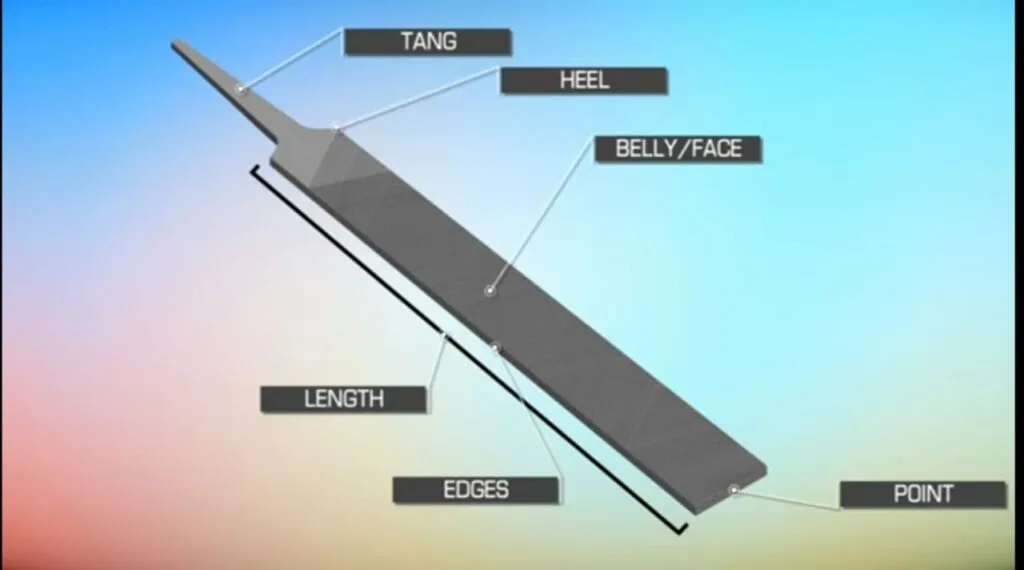
- Face
This is the flat surface of the file. The tiny sharp lines or teeth used for cutting are made on this surface. This is the working part of the file. - Tang
The tang is the thin, pointed part at one end of the file. This is where the handle is attached. You never hold the tang directly with your hands. - Handle
The handle is the part that is fixed to the tang. It helps you hold and use the file comfortably. Most handles are made of wood or plastic. - Heel
This is the plain area between the face and the tang. It has no teeth on it. It works as a base where the cutting part ends and the tang begins. - Core
The core is the thin section of the file that has just one line of teeth going in a straight row. It is used for fine and straight filing. - Tip or Point
This is the very end of the file, opposite the handle. It is also called the tip. The size of this point helps in choosing the right size of the handle. - Shoulder
This is the part between the heel and the tang. It is a slightly narrower section and helps in forming the tang. It gives the file its strong shape. - Ferrule
This is a small metal ring fitted at the end of the handle. If the wooden handle gets a crack, the ferrule helps hold it together and stops it from breaking. It also protects your hand from getting hurt.
Classification of Files
(Based on Shape types of files tool)
Files are useful tools that help us smooth or shape metal, wood, and other materials. They come in different shapes, and each shape has its own special use.
Let’s first look at one types of files tool based on its shape:
1. Flat File
A flat file is shaped like a rectangle. It is flat on both sides, just like a ruler, but it has tiny teeth for cutting.

- Both flat surfaces have teeth that are either in single rows or double rows.
- Both edges also have teeth, but they are made with single straight lines.
- These files are commonly found in lengths between 15 to 40 centimeters.
It is used most in workshops. Flat surfaces can be created with it.
Hand File (Flat Sand Type)
A hand file looks like a rectangle. Its width stays the same from the top to the bottom. On one edge, it has tiny sharp lines called teeth, which help smooth things like metal or wood.
The other edge has no teeth at all—this is called the safe edge. The safe edge is used when we don’t want to scratch or damage the surface next to the one we are working on.
It’s a smart little tool, simple but very useful!
🧰 Mill File (For Smooth Shaping)
The mill file is also straight and keeps the same width and thickness all the way. But what makes it special is its edges—they can be flat, round, or even diamond shaped.
These edges have sharp teeth too, but they are single cut, which means the lines go in one direction. This file is great for shaping things like grooves, especially ones that are half-circle shaped.
Triangular File
A triangular file is a special type of hand tool. If you look at its shape from the side, it looks like a triangle. That’s why it is called a triangular file.
This file has three flat faces, and all three are equal in size. On each face, there are tiny sharp lines called teeth, which help in cutting or shaping things. These teeth are usually made in one direction, which is known as a single cut.
This tool is mostly used for sharpening the teeth of saws, so they can cut better. It is also very useful for cleaning or shaping sharp corners in square or triangular grooves—places where other files might not fit properly.
Square File
This file has a square-shaped cross-section, which means if you cut it and look from the side, it looks like a square.
It is mainly used for cleaning and shaping narrow slits, square holes, or small rectangular spaces.
It can easily reach into sharp corners where round tools can’t go.
Imagine using a square pencil to clean the edges of a tiny box—that’s how this file works!
. Round File
As the name says, this file has a round (circular) shape.
It has teeth all over its curved surface, and it’s best for filing round or curved spaces like holes or pipes.
It’s smooth and helps create even, rounded shapes.
If you want to make a hole smoother and rounder, this is the file you need.
Half Round File
This file has a semi-circle shape—flat on one side and curved on the other.
The curved side has fine single-cut teeth, and the flat side usually has double-cut teeth.
It is used for both flat surfaces and curved inner areas.
Think of it like a “two-in-one” file—it can smooth both straight and rounded shapes!
Knife Edge File
This file looks like the edge of a knife. One side is sharp and tapers to a fine point.
It is very useful for filing in tight, narrow spaces where other files cannot reach.
If you need to clean a tiny corner or a very slim slit, this is the perfect tool.
Types of Files tool Based on Tooth Cutting
The shape and style of the teeth on a file decide how it works. Just like how different combs are used for different hair types, different files are used for different materials. Based on the way their teeth are cut, files are mainly of five types. Let’s understand them in a very simple way:
Let’s first look at one types of files tool based on its Tooth Cutting :
Single Cut File
This type of file has straight lines of teeth on its surface. These lines are all going in the same direction and are made at an angle of 60 degrees.
They are like neat rows, side by side, just like lines in a notebook.
- These files don’t remove too much metal.
- But they make the surface very smooth and clean.
- They are perfect for sharpening tools and for smoothing hard metals.
- These files only work when you push them forward, not backward.
🛠️ Simple Use: When you want to polish or make a surface look clean and shiny.
2. Double Cut File
This file is a little different. It has two sets of teeth, both crossing each other like a criss-cross pattern.
- The first set of teeth is made at 70 degrees. These are called over cuts.
- The second set is made over the first at an angle of 51 degrees. These are called up cuts.
- Because of this double cutting, this file removes more material.
- But it leaves the surface a little rough, not as smooth as the single cut.
🛠️ Simple Use: When you want to remove more metal quickly, like in heavy or rough work.
3. Rasp Cut File
This file looks very different. Its teeth are not made in straight lines.
They are punched on the surface one by one, with a little space between each.
- These teeth are not connected like in the other two.
- This file is best for soft things like wood, rubber, leather, or even horse hooves.
- It helps to shape, smooth, or carve these soft materials easily.
🛠️ Simple Use: When you want to shape or smooth soft things without damaging them.
Circular Cut File
A circular cut file has teeth that are not straight, but made in a round or circular shape. All the teeth are placed parallel to each other in this round pattern.
This file is mostly used to cut soft metals. It removes only a very small amount of material at a time, so the cutting is slow but smooth.
It is useful when we want to shape or smooth soft metal without damaging it.
Just imagine drawing small circles again and again — that’s how this file works!
Spiral Cut File
A spiral cut file has teeth made in a spiral shape. These teeth begin from the point of the file and go round and round until they reach the heel (the end part).
This type of design is mostly found in round files.
Because of the spiral shape, it cuts smoothly and removes material evenly as you move it.
Think of it like peeling a fruit in one long spiral — that’s how this file shapes the material!
types of files tool Based on the Grade of Teeth
The grade of teeth means how thick or fine the teeth on a file are. It tells us how many teeth are made in one centimeter.
Let’s first look at one types of files tool based on its Grade of Teeth:
If there are fewer teeth in 1 cm, the file has bigger and rougher teeth.
If there are more teeth in 1 cm, the file has smaller and finer teeth.
Depending on how many teeth a file has, it can be of different types:
1. Rough File
- This file has 8 teeth in one centimeter.
- Its teeth are very big and rough.
- It can remove a lot of metal very quickly.
- But it can slip on hard metals, so it is best used for soft metals like aluminum or copper.
- This file works well when we want to remove a thick layer.
2. Circular Cut File
- In this file, the teeth are not straight, but they are made in a circular pattern.
- All the teeth go in the same direction.
- It is used on soft metals and removes only a small amount of material.
- It gives a smooth finish and is used when we want to be careful and not cut too much.
3. Spiral Cut File
- The teeth of this file are spiral-shaped.
- They start from the tip of the file and go all the way to the handle side.
- This type of cut is usually seen in a round file.
- It helps in cutting evenly and smoothly on curved or round surfaces.
. Bastard File
This file has 12 teeth in every centimeter. It is called a medium-grade file.
You can use it on both hard and soft metals.
That’s why it is the most commonly used file.
It is strong, useful, and works for many types of jobs.
(See the picture below to understand its grade)
2. Second Cut File
This file has 16 teeth per centimeter, so it is finer than the bastard file.
It is used when you want a better and smoother surface after the first filing.
It gives a neat finish to your work.
(See the picture below to understand its grade)
3. Smooth File
This file has 20 to 24 teeth in one centimeter.
It removes a very small amount of metal, so it is used for light and soft work.
It gives a clean and fine finish.
(See the picture below to understand its grade)
4. Super Dead Smooth File
This is the finest file of all.
It has 40 to 65 tiny teeth in one centimeter.
It is used when we want a very smooth and shiny surface.
It gives perfect results and is used for accurate and delicate work.
(See the picture below to understand its grade)
types of files tool Based on Length
Files are also grouped by how long they are. The length of a file means the distance from its tip (the point) to the end (the heel).
Let’s first look at one types of files tool based on Length:
In the market, you can find files that are between 10 cm and 45 cm long.
Files shorter than 10 cm are also available. These very small ones are used for very tiny or detailed work.
- Small files (10 to 15 cm long) are used when you need to do fine or delicate work.
- Medium files (15 to 25 cm long) are good for normal or everyday work.
- Large files (25 to 45 cm long) are strong and are used for heavy or big work.
Other Types of Files Tool
Apart from the common file types we’ve already talked about, there are many other useful files. These are often used for special tasks that need extra care and detail. Below is a simple and clear explanation of each one. Take a look and see how each file has its own job and shape.
Let’s first look at one types of files tool based on its special tasks :
🔸 Barrette File
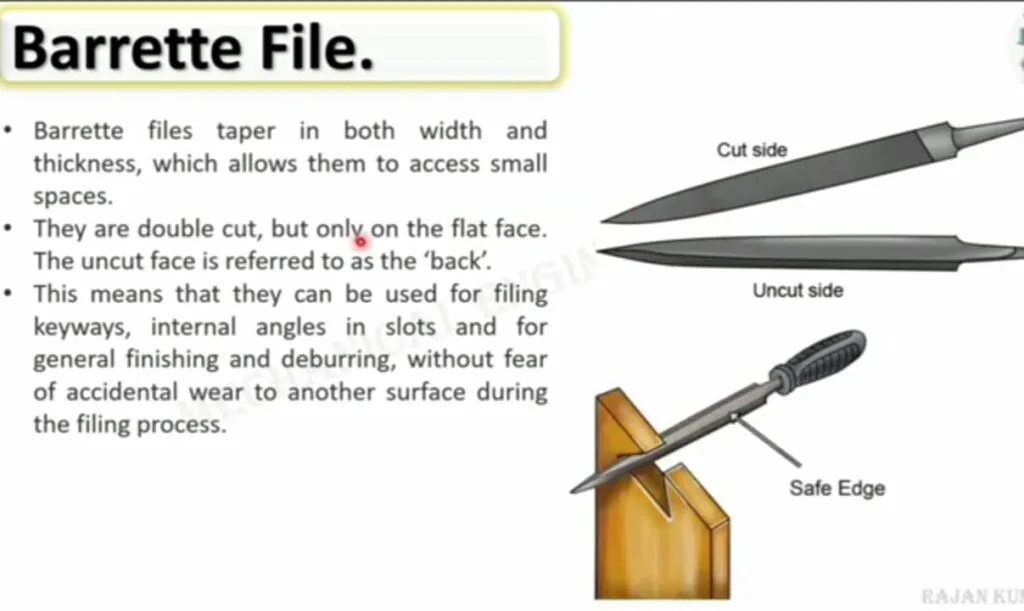
This file is narrow and pointed at the end. Only one flat side has teeth, while the other sides are smooth and safe to touch. It’s great for making flat surfaces smooth.
🔸 Checkering File
This file is almost the same size from top to bottom. Its teeth are cut in a criss-cross grid pattern. It is used for making tiny grooves, like the ones you see on gun handles or tools.
🔸 Crochet File
It gets narrower at the tip and has curved edges all around. This file is used where flat and curved surfaces meet, or in small rounded spaces.
🔸 Crossing File
It has two curved sides, but one side is more round than the other. It’s perfect for filing inside curves or places where two curved shapes meet.
🔸 Dreadnought & Millenicut Files
These are heavy-duty files with big, sharp teeth. They can remove a lot of material quickly, especially from metal or plastic car parts.
- Dreadnought has curved teeth
- Millenicut has straight teeth
🔸 Equaling File
This file is flat and even on both sides. It’s used for filing slots and corners neatly.
🔸 Farrier Rasp File
Used by people who work with horses and metal, this file has two sides:
- One side is rough like a rasp
- The other side has straight teeth
🔸 Fret File
This file is small and has a groove on one side. It’s used by guitar makers to shape the frets, which are the metal lines on the neck of a guitar.
🔸 Half Round Ring File
This is a small, curved file used for shaping the inside of rings or other small round objects.
🔸 Joint Round Edge File
This file has rounded sides with teeth and flat sides that are smooth. It’s good for making hinges or joints where smooth movement is needed.
🔸 Knife File
It looks like a knife with a curved edge and stays the same thickness along its length. It’s used to cut narrow slots or shapes like a wedge.
🔸 Nut File
These are tiny files that come in sets of different thicknesses. Guitar makers use them to shape the small slots where the strings sit at the top of the guitar.
🔸 Pillar File
Long and narrow, this file has smooth sides and is used for very flat and accurate filing.
🔸 Pippin File
This file has a shape like a tear drop. It’s great for filing between two curves or making V-shaped grooves.
🔸 Plane Maker’s Float
This file is long and straight with teeth on one side. It’s used by woodworkers, especially when making wooden hand planes, to smooth and shape wood.
🔸 Round Parallel File
This file is like a round stick with teeth all around. It’s used for cleaning and shaping round holes, and it doesn’t get thinner at the end.
🔸 Saw Sharpening File
These files are made to keep saw teeth sharp. They are smooth and gentle, giving a fine edge. One type is the chainsaw file, which is shaped to fit perfectly on the saw teeth.
🔸 Slitting File
This file is thin and shaped like a diamond. It is used to file narrow slots in a neat and clean way.
🔸 Warding File
This one is flat and pointed at the end, perfect for slotting or flat surface work. It’s very useful for detailed shaping.
Precautions While Using a File
Using a file and sandpaper safely and correctly is very important. Here are some simple things you should always keep in mind:
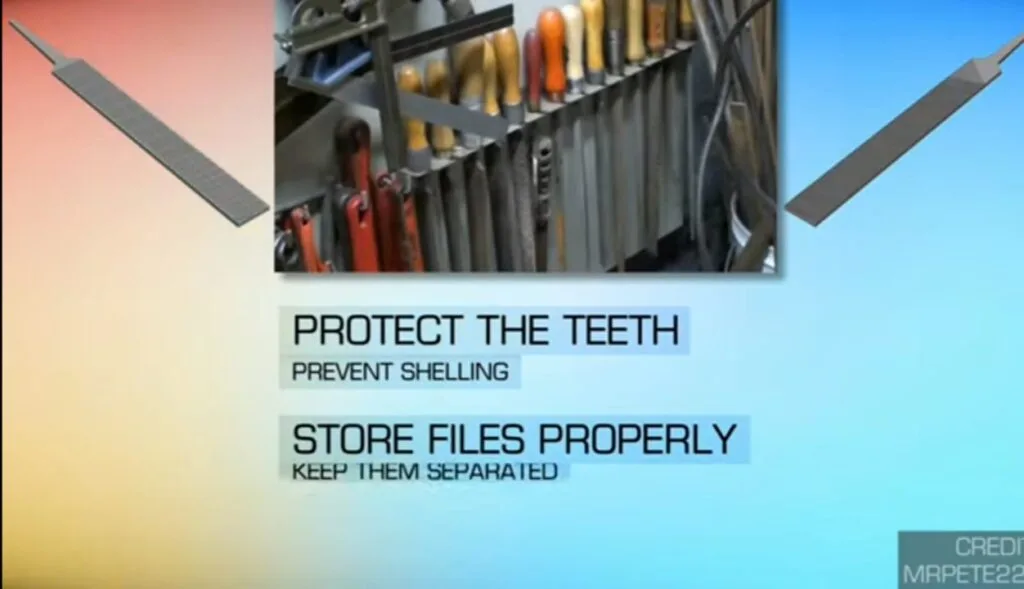
- Try New Sandpaper on Soft Metal First
When you use new sandpaper, always test it first on a soft metal. This helps to smooth out any sharpness and makes it work better. - Don’t Hit the File on the Work
Never bang or hit the file on the job. If you do that, the small teeth on the file can break, and it won’t work properly anymore. - Wash the Sandpaper After Some Time
After using the sandpaper for one or two months, give it a gentle wash. This helps to remove the dust stuck in it and makes it last longer. - Use a File Card to Clean It
Keep a small tool called a file card with you. Use it to clean the iron bits or dust stuck in the sandpaper. If you clean it from time to time, it will keep working well.
Conclusion of File Tool (In Simple, Clear Language)
The File Tool is a very helpful thing. It is used to open, save, edit, and manage files easily. Just like we use a school bag to keep all our books in one place, the file tool helps keep all our work safe and in order on the computer.
It helps us do things like:
- Save our work so we don’t lose it.
- Open it later whenever we need it.
- Change or fix anything if we made a mistake.
- Organize different files so we can find them quickly.
In short, the file tool is like a smart helper that keeps our computer work neat, safe, and easy to find. It makes our work simple and smooth. Whether we are writing, drawing, or doing school projects, the file tool is always there to help!
fAQ
What is a file tool used for in electrical work?
A: A file is used to smooth, shape, or remove small amounts of material from metal parts such as wires, terminals, or metal enclosures.Why do electricians use files?
A: Electricians use files to clean contacts, deburr cut metal edges, or shape electrical enclosures to fit components properly.What material are electrical files made of?
A: They are usually made of hardened steel with fine or coarse teeth to cut through metal.How do I maintain a file tool?
A: Clean it with a wire brush after use, avoid dropping it, and store in a dry place to prevent rust.Is it safe to use a file on copper wires?
A: Yes, but use gently and only to clean or shape ends — do not file while the wire is live.

